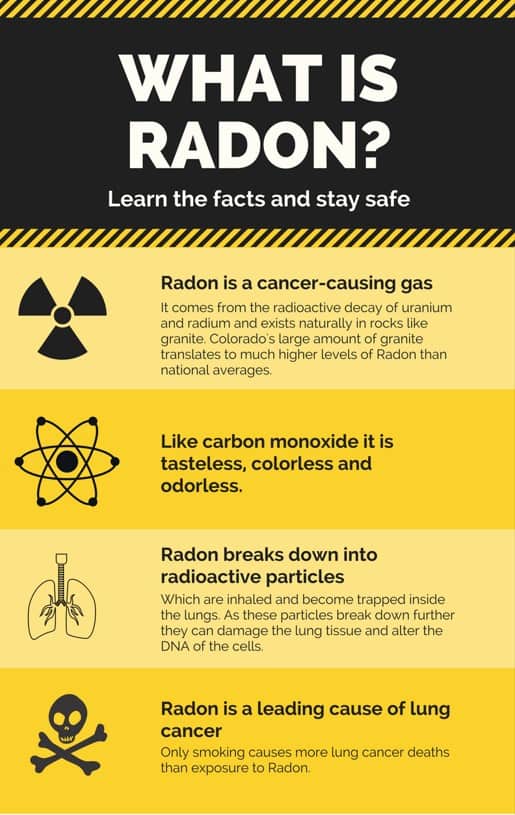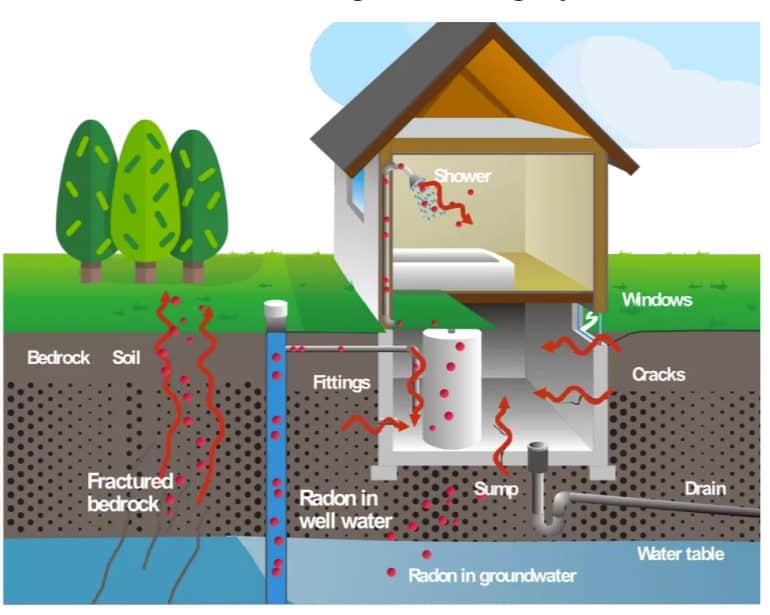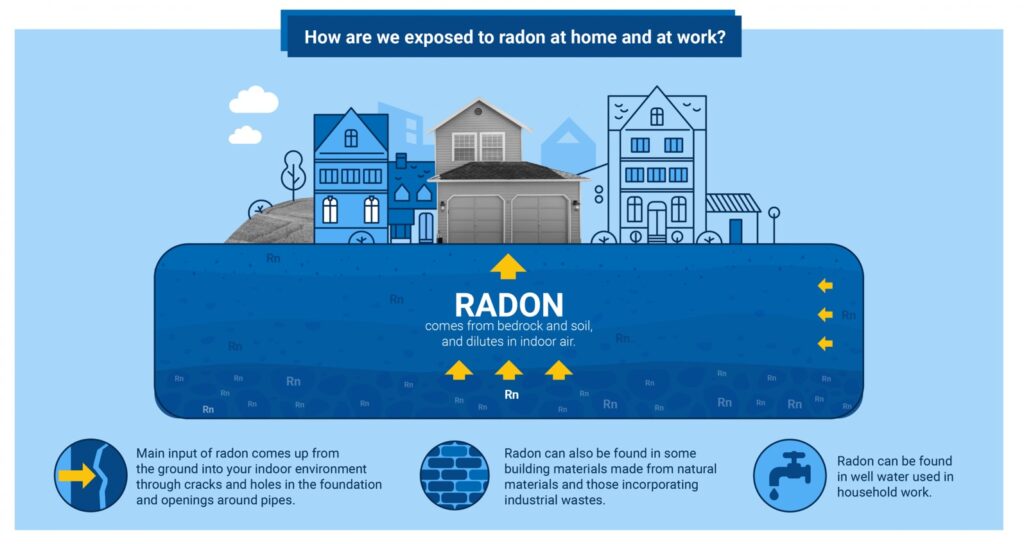Maintaining healthy indoor air quality is crucial for our well-being, as we spend a significant amount of time indoors.
One potential indoor air pollutant of concern is radon, a radioactive gas that can seep into buildings from the ground.
Radon exposure is associated with an increased risk of lung cancer, making it essential to monitor indoor radon levels.
Can Indoor Air Quality Monitors Detect Radon?
Certain indoor air quality monitors can detect radon gas as they are equipped with radon sensors specifically designed to detect its presence in indoor environments. These monitors measure radon levels and provide readings to alert occupants if concentrations exceed recommended safety thresholds.
Radon is a naturally occurring radioactive gas that forms from the decay of uranium in soil, rock, and water. It is colorless, odorless, and tasteless, making it imperceptible to human senses.
is a naturally occurring radioactive gas that forms from the decay of uranium in soil, rock, and water. It is colorless, odorless, and tasteless, making it imperceptible to human senses.
Radon can enter buildings through cracks in the foundation, gaps in construction materials, or openings around utility penetrations.
Once inside, radon can accumulate to harmful levels, posing a health risk to occupants through inhalation.

While most indoor air quality monitors are capable of detecting various pollutants such as particulate matter, volatile organic compounds (VOCs), carbon dioxide (CO2), and carbon monoxide (CO), their ability to detect radon may be limited.
are capable of detecting various pollutants such as particulate matter, volatile organic compounds (VOCs), carbon dioxide (CO2), and carbon monoxide (CO), their ability to detect radon may be limited.
Unlike other pollutants that can be measured directly with sensors, radon requires specialized detection methods due to its radioactive nature.
The University of Porto conducted a study to assess low-cost indoor air quality monitors for short-term continuous radon monitoring in nursery and primary school buildings.
conducted a study to assess low-cost indoor air quality monitors for short-term continuous radon monitoring in nursery and primary school buildings.
Five classrooms were chosen, and radon levels were measured using both reference instruments and commercially available low-cost IAQ monitors.
The study found that indoor IAQ monitors worked about the same as the reference instrument and had good short-term monitoring results, which suggests they could be used to actively lower radon levels in schools.
Radon Detection Methods:
There are two primary methods for detecting radon in indoor environments:
Active Radon Detection: Active radon detection involves using specialized radon monitors equipped with alpha particle detectors or ionization chambers
or ionization chambers  to measure radon levels continuously.
to measure radon levels continuously.
These monitors typically require power sources and may be more expensive than passive detectors. Active radon monitors provide real-time radon concentration data and are commonly used for long-term radon monitoring in homes, workplaces, and other indoor spaces.
typically require power sources and may be more expensive than passive detectors. Active radon monitors provide real-time radon concentration data and are commonly used for long-term radon monitoring in homes, workplaces, and other indoor spaces.

Passive Radon Detection: Passive radon detection involves using passive devices such as charcoal canisters, alpha track detectors, or electret ion chambers to collect radon over a specified period, typically several days to several months.
Passive detectors do not require power sources and are relatively inexpensive and easy to use. After the collection period, the detectors are sent to a laboratory for analysis, and the radon concentration is determined based on the degree of radioactive decay observed.
While all indoor air quality monitors are not specifically designed to detect radon, some advanced models offer radon detection capabilities as an additional feature.
These monitors typically use active detection methods and may require calibration or periodic maintenance to ensure accurate radon measurements.
Choosing the Right Method:
The choice between active and passive radon detection methods depends on various factors, including monitoring objectives, budget, and technical requirements.
methods depends on various factors, including monitoring objectives, budget, and technical requirements.
Active radon detection is suitable for continuous, real-time monitoring and is often preferred for long-term radon assessments in buildings.
and is often preferred for long-term radon assessments in buildings.
Passive radon detection is convenient for short-term measurements and can be used for initial screening or as part of radon testing campaigns.
What are the recommended radon levels for indoor environments?
The Environmental Protection Agency (EPA) and the World Health Organization (WHO) have established guidelines for indoor radon levels to protect public health.
The recommended radon levels differ slightly between these organizations but generally fall within the range of 2 to 4 picocuries per liter (pCi/L) of air.
EPA Recommendation: The EPA recommends taking action to mitigate radon levels if indoor concentrations exceed 4 picocuries per liter (pCi/L), as this is considered the “action level” for radon exposure in the United States.
recommends taking action to mitigate radon levels if indoor concentrations exceed 4 picocuries per liter (pCi/L), as this is considered the “action level” for radon exposure in the United States.
However, the EPA also acknowledges that there is no safe level of radon exposure and encourages homeowners to consider mitigation measures even at lower concentrations.
WHO Recommendation: The WHO recommends a lower threshold for radon exposure, suggesting that indoor radon levels should not exceed 2.7 picocuries per liter (pCi/L) of air.
The WHO considers radon a carcinogenic hazard and emphasizes the importance of reducing radon exposure as much as possible to minimize the risk of lung cancer.
considers radon a carcinogenic hazard and emphasizes the importance of reducing radon exposure as much as possible to minimize the risk of lung cancer.
How do I reduce radon in my home?
If radon levels in a building exceed the recommended thresholds, mitigation measures should be implemented to reduce radon concentrations and minimize health risks. Common radon mitigation strategies include:
Soil Depressurization: This method involves installing a vent pipe and fan system to draw radon gas from beneath the building and vent it outdoors, preventing its entry into the indoor environment.
Sealing Cracks and Openings: Sealing cracks in the foundation, walls, floors, and around utility penetrations can help prevent radon from entering the building.
Improving Ventilation: Increasing ventilation rates and airflow within the building can help dilute radon concentrations and reduce exposure levels.
Radon Testing and Monitoring: Regular radon testing and monitoring are essential for assessing indoor radon levels and ensuring that mitigation measures are effective in maintaining radon concentrations below recommended thresholds.
What Are The Health Effects of Radon Exposure?
Exposure to elevated levels of radon is the second leading cause of lung cancer after smoking.
When inhaled, radon decay products emit alpha particles
products emit alpha particles that can damage lung tissue and increase the risk of developing lung cancer over time.
that can damage lung tissue and increase the risk of developing lung cancer over time.
The risk of radon-related lung cancer depends on factors such as the concentration of radon, the duration of exposure, and individual susceptibility.
Long-term exposure to radon can have serious health consequences, making radon detection and mitigation critical for protecting public health.
Lung Cancer Risk:
Radon exposure is recognized as the second leading cause of lung cancer globally, following smoking.
When radon gas is inhaled, it undergoes radioactive decay, emitting alpha particles that can damage lung tissue and DNA.
Over time, exposure to radon and its decay products increases the risk of developing lung cancer.
The risk is proportional to the concentration of radon, the duration of exposure, and individual susceptibility factors such as smoking history and genetic predisposition.
Mechanism of Action:
Alpha particles emitted during the decay of radon and its progeny can penetrate lung tissue, causing ionization and DNA damage.
and DNA damage.
This DNA damage can lead to mutations and alterations in cell growth regulation, contributing to the development of lung cancer.
The carcinogenic effects of radon exposure primarily target the bronchial epithelial cells lining the airways, where alpha particles deposit their energy.

Risk Factors:
While everyone exposed to radon is at risk of developing lung cancer, certain factors can increase susceptibility.
Individuals who smoke or have a history of smoking are at a significantly higher risk of radon-induced lung cancer. Smoking combined with radon exposure synergistically amplifies the risk of lung cancer.
Other risk factors include the concentration of radon in indoor air, the duration of exposure, and genetic predisposition to cancer.
Long-Term Consequences:
The health effects of radon exposure are cumulative and often manifest over many years or decades.
Prolonged exposure to elevated radon levels can lead to the development of lung cancer, which may remain asymptomatic until advanced stages.
Radon-induced lung cancer accounts for a substantial proportion of lung cancer cases worldwide, highlighting the importance of radon detection and mitigation in public health strategies.
FAQs
How can I test my home for radon?
Radon testing kits are available for homeowners to test their homes for radon. These kits may include passive radon detectors such as charcoal canisters or alpha track detectors, along with instructions for placement and retrieval.
After the specified testing period, the detectors are sent to a laboratory for analysis, and the radon concentration is determined.
Can radon levels vary throughout the year?
Radon levels can fluctuate seasonally and depend on factors such as soil moisture, temperature, and ventilation patterns.
However, long-term radon testing is recommended to assess average radon levels accurately.
What are the health effects of radon exposure?
Radon exposure increases the risk of developing lung cancer, particularly among smokers.
When inhaled, radon decay products emit alpha particles that can damage lung tissue and lead to cancerous growth over time.
Conclusion:
While indoor air quality monitors are valuable tools for monitoring various pollutants in indoor environments, their ability to detect radon may be limited.
for monitoring various pollutants in indoor environments, their ability to detect radon may be limited.
Radon detection typically requires specialized radon monitors equipped with alpha particle detectors or ionization chambers.
Homeowners concerned about radon exposure should consider using radon testing kits or hiring qualified professionals to assess radon levels in their homes.
By taking proactive measures to detect and mitigate radon, individuals can reduce their risk of radon-related health effects and create safer indoor environments.

